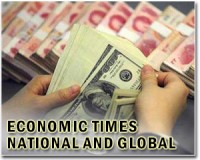| . |  |
. |
Houston TX (SPX) Oct 21, 2010 By applying the same rules that explain how genomes evolve, Rice University physicists have shown that the world economy is more sensitive to recessionary shocks and recovers more slowly from recessions now than it did 40 years ago, due to increased trade globalization. Their findings are available online and will appear in an upcoming issue of the Physical Review Letters. "Standard economic theory suggests that trade networks with a more modular structure tend to recover more slowly from recessions, but using evolutionary theory we predicted the opposite, and U.N. trade data indicate we were right," said Michael Deem, the John W. Cox Professor in Biochemical and Genetic Engineering and professor of physics and astronomy at Rice. Deem and co-author Jiankui He, a graduate student in physics and astronomy, studied United Nations trade data from the past 40 years and found the global economy has tended to react more sharply to recessions and to recover more slowly from them as globalization has increased. The concept of modularity is key to understanding their findings. In biology, a module is a structure that is part of a larger system but can also function partly on its own, in much the same way that a modular piece of furniture might function either by itself or as part of larger ensemble. In living things, modularity is rampant at every scale - from the genomes inside cells to the organs in human bodies. In 2007, Deem and former postdoctoral fellow Jun Sun offered an explanation for biological modularity. They showed that modularly arose spontaneously in systems where evolution occurred relatively slowly and where information - like genes - could be swapped. "What we showed in 2007 was that under certain conditions, a changing environment leads to the development of a modular structure," Deem said. "We considered the world trade network to be an evolving system, and we know information in the form of business practices is readily swapped throughout the trade network. Since it matches the conditions for our theory, we hypothesized that it would also follow the same physical rules." To test their idea, He and Deem had to create a mathematical description of the global trade network. Scientists often use a tree-like structure to study networks - much like a geneologist might use a family tree to describe family relationships. By applying a tree-like geometry to the U.N. data, Deem and He computed a variable called the "CCC" that described the amount of modularity in the global trade network for any given year. In a "flattened" global economy, CCC is low, and it increases as modularity in the trade network increases. Examples of increased modularity could include protectionist tariffs or regional trade associations, each of which acts to restrain trade between countries. "Another of our predictions was that recessions would cause the world trade network to become more hierarchical, and this is something that was borne out by the data as well," Deem said. "With increasing globalization, we see the CCC trending down since 1969, but we also see it increasing, for a brief period, after each recession." Deem and He found the trend held true for three major recessions and four minor ones over the past four decades.
Share This Article With Planet Earth
Related Links Rice University The Economy
 China raises US debt holdings amid global surge
China raises US debt holdings amid global surgeWashington (AFP) Oct 18, 2010 China raised its US debt holdings in August as global appetite surged for long-term Treasury bonds seen as a safe haven amid economic uncertainty, official data showed Monday. China, excluding Hong Kong, remained by far the biggest holder of Treasury bonds and notes: 868.4 billion dollars' worth, reflecting an increase of 21.7 billion dollars from July, the Treasury Department reported. ... read more |
|
| The content herein, unless otherwise known to be public domain, are Copyright 1995-2010 - SpaceDaily. AFP and UPI Wire Stories are copyright Agence France-Presse and United Press International. ESA Portal Reports are copyright European Space Agency. All NASA sourced material is public domain. Additional copyrights may apply in whole or part to other bona fide parties. Advertising does not imply endorsement,agreement or approval of any opinions, statements or information provided by SpaceDaily on any Web page published or hosted by SpaceDaily. Privacy Statement |